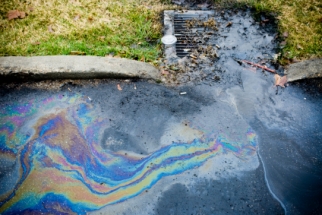What is a Watershed?
Purpose of Watershed Protection
Lake Huron Watersheds
Bi-National Partnership
Contact Us
Home > Pollutants
Stormwater Runoff | Storm Sewers | Lawn Care | We're All Connected
If we pollute the  watersheds surrounding a lake, stream, or river, we’re directly affecting the water quality in that lake, stream, or river. Even if your house is not on the waterfront, storm drains or storm sewers carry runoff from your neighborhood to the nearest stream, wetland or body of water.
watersheds surrounding a lake, stream, or river, we’re directly affecting the water quality in that lake, stream, or river. Even if your house is not on the waterfront, storm drains or storm sewers carry runoff from your neighborhood to the nearest stream, wetland or body of water.
Picture: Michigan Water Stewardship Program
In a natural watershed, rain falls on grassy or vegetated areas. Vegetation allows the soil to soak up most of the rain that falls. In an urban watershed, rain falls on hard surfaces such as streets, driveways, and rooftops. The rain water runs quickly over these hard surfaces and is not soaked up. This moving water is called storm water runoff.
Storm water runoff is a result of rainfall and melting snow. As this water flows to storm sewers, it picks up pollutants. Pollutants in storm water runoff include soil, oil and antifreeze from streets and driveways, leaves and grass clippings from gutters and streets, animal wastes from lawns and gutters, and fertilizers and pesticides from lawns and gardens.
The loss of vegetated areas due to urbanization and development dramatically increases the volume of storm water runoff. Urbanization also increases the amount of pollutants available to be picked up by storm water.
You don’t need a heavy rainstorm to send pollutants rushing toward streams, wetlands and lakes—your hose can supply enough water.
Contrary to popular belief, most street storm drains do not carry stormwater to sewage plants for treatment. Often they flow directly into the water you enjoy for swimming and fishing.
Storm sewers are designed to prevent flooding, but also provide direct routes for pollutants to lakes and streams. By controlling the pollutants in storm water runoff, we can control the amount of pollution entering our lakes and streams.
Phosphorus is one of the most troublesome pollutants in storm water runoff. Phosphorus comes from many sources, and it is the primary cause of water quality problems in our lakes and streams.
Everything that is or was living contains phosphorus. It is in leaves. It is in lawn clippings. It is in animal wastes. It is an ingredient in most lawn fertilizers. It is even attached to soil. When leaves, lawn clippings, animal wastes, fertilizers, and soil are picked up by storm water runoff and are carried directly to our local lakes and streams, they provide the lakes with excess phosphorus. This excess phosphorus causes increased algae growth.
Algae are small green plants that live in lakes and streams. Increased algae growth is observed as green algae blooms or “scums” on lakes. Too much algae is harmful to a lake system. It blocks sunlight and prevents other plants from growing. When it dies and decays, it also takes much needed oxygen away from fish. Limiting phosphorus reduces algae blooms.
The water doesn't stop when it reaches the nearest lake, stream or river. It keeps flowing into larger and larger bodies of water. In Michigan watersheds, small streams flow into major rivers which all empty into the Great Lakes. Water in the Great Lakes continues to flow eastward through the St. Lawrence River and eventually into the Atlantic Ocean. Groundwater follows this same path.
So a drop of water falling on your house in Michigan may travel through all of those bodies of water and end up in the ocean. Just as that drop of water falling on your house in Michigan may have traveled to you from the other side of the earth.
Northeast Michigan Council of Governments
80 Livingston Blvd. | PO Box 457
Gaylord, MI 49734
(989) 705-3730 | nemcog.org


